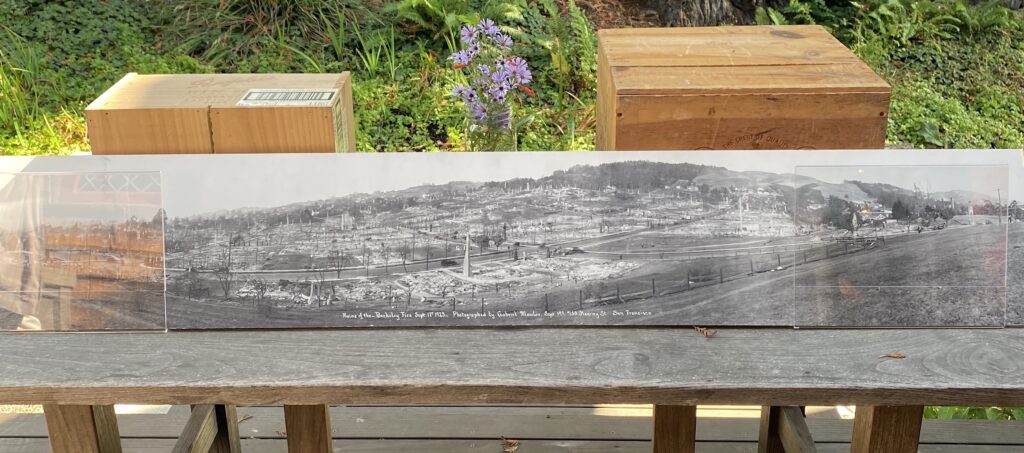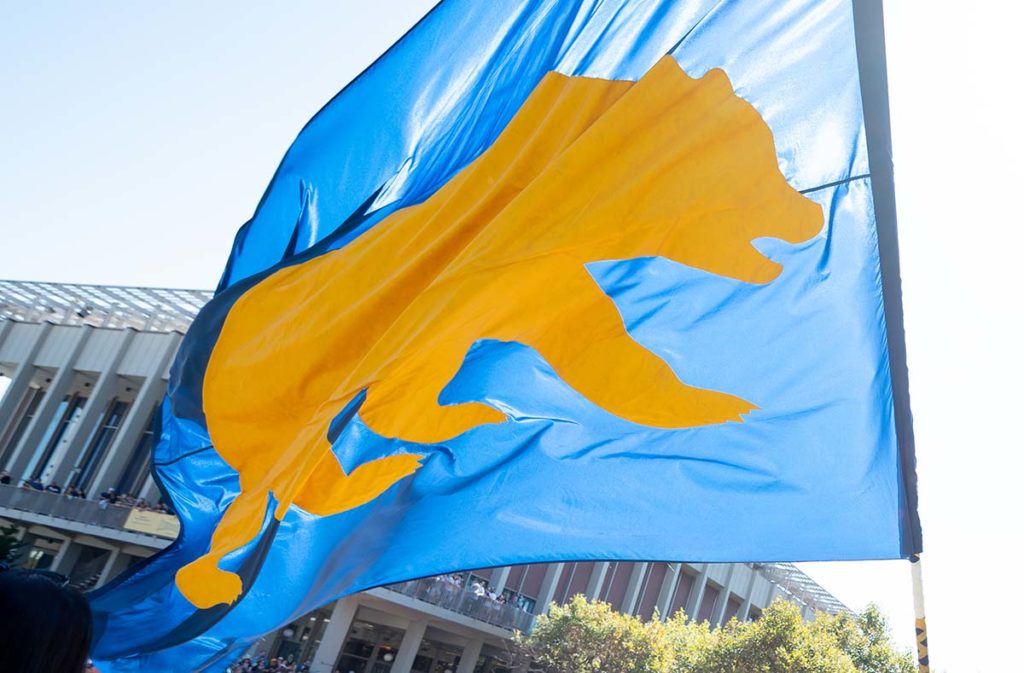North Berkeley was a showcase for the city’s exceptional architects. As it turned out, it was also a tinderbox.
The first signs of trouble were subtle. For some, it was the strange amber hue of the midday light. Others caught the distinctive scent of burning eucalyptus. By two in the afternoon of September 17, 1923, just about everyone in Berkeley had taken note of the uncommonly warm, dry wind blowing in from the northeast. What they didn’t know was that a small grass fire over the hill in Wildcat Canyon was growing fast, leaping from grass to brush to tree—and it was about to crest the hills of North Berkeley.
At final tally, more than 500 homes were destroyed. Miraculously, no one was killed, but 4,000 people were left homeless.
When it did, near Berryman Reservoir, the fire was a half mile wide. A thick black cloud came pouring over the hill, followed by surging flames pressed low by warm, gale-force winds, known as Diablo winds. The fire raced down Codornices Creek and bore down on the Northside neighborhood that ran from the creek to the northern edge of the Berkeley campus at Hearst Avenue.
Just a few decades earlier, at the turn of the century, the area had been sparsely developed pastureland known as Daley’s Scenic Park. But, spurred in part by immigration across the bay after the San Francisco earthquake of 1906, there was a surge of subdivision and construction. In that short period, something remarkable had taken place. A group of renowned Berkeley architects including Bernard Maybeck, John Galen Howard, and Julia Morgan had chosen the neighborhood as the ideal setting to express a philosophy of house design summed up in the book, The Simple Home, by another prominent Berkeleyan, poet and naturalist Charles Keeler.
Inspired by the principles of the Arts and Crafts movement, Keeler espoused the virtues of homes that complemented the beauty of the natural setting in which they were built. His book described the ideal abode as one of unpainted redwood shingles, raw redwood interiors with rough-hewn beams and minimal adornments. Lush gardens blurred the lines between developed and natural spaces. In building such a home, Keeler wrote, “man is conjuring the beauties of nature into being at his very doorstep.”
The construction of these “Berkeley Brown Shingles” was vigorously promoted by North Berkeley’s Hillside Club, a Berkeley women’s group that included the wives of several prominent architects, who wholeheartedly subscribed to Keeler’s design aesthetic. By 1923, the neighborhood was dense with woodsy Craftsmans, 90 percent of them covered top to bottom in redwood shingles. It was a showcase for Berkeley’s exceptional architects. As it turned out, it was also a tinderbox.
As the fire roared downhill, the shingled homes literally exploded in flames. Berkeley’s small contingent of firefighters was forced to repeatedly abandon their positions as the wind-propelled fire speedily advanced. The entire city, it seemed, might be consumed. But just as the flames reached the shopping district at Shattuck Avenue to the west and campus to the south, the wind reversed direction and the fire was blown back onto itself. With nothing left to consume, it died out.
Replacement homes were built with fire-resistant stucco siding and clay tile roofs, creating a delineation in house design that marks the path of the fire to this day.
When North Berkeley residents returned, there was nothing to salvage. It was a naked hellscape of charred tree trunks and freestanding chimneys surrounded by bare foundations.
At final tally, more than 500 homes were destroyed. Miraculously, no one was killed, but 4,000 people were left homeless, including more than 100 University employees and faculty and over 1,000 students. Much of Berkeley’s contribution to the history of American residential architecture had been reduced to ash. Maybeck alone saw 19 of his projects consumed by the flames.
In the aftermath, there was little doubt that the neighborhood’s characteristic nature-inspired homes had added fuel to the inferno. The style of building that predominated in Northside before the 1923 fire is exemplified by UC Berkeley’s Northgate Hall at Hearst and Euclid. Today it’s home to the Graduate School of Journalism, but at the time the building, designed by John Galen Howard, housed the architecture school. As the fire bore down on campus, architecture students stood on the roof with hoses defending the “Ark,” as it was called, from the blaze. Howard’s own home burned to the ground, as did Maybeck’s.
Keeler did not hesitate to reexamine his design tenets in the wake of the catastrophe. “Half measures of protection will not serve,” he wrote at the time. “Let Berkeley citizens prove themselves men and women of vision who dare to face the problems in a big way and build for the future and avoid the mistakes of the past.”
In the aftermath, replacement homes were built with fire-resistant stucco siding and clay tile roofs, creating a delineation in house design that marks the path of the fire to this day.
But lessons of disaster fade with time. In 1991, fire struck the East Bay hills again, this time at the Berkeley-Oakland border, killing 25 people and destroying more than 3,000 homes. In the aftermath, houses with redwood shingle siding and split shake roofs once again caught much of the blame for the ferocity of the fire. The similarities didn’t end there. In both cases, dense urban forest comprised of volatile species like blue gum eucalyptus and Monterey pine contributed to catastrophe. Both fires occurred on unseasonably warm, dry fall days. And both were propelled by hot, gusty winds from the northeast. In both cases, the fire was only contained when these winds subsided or reversed.
Lessons of disaster fade with time. In 1991, fire struck the East Bay hills again, killing 25 people and destroying more than 3,000 homes.
In her book about the 1991 fire, Firestorm!, journalist Margaret Sullivan points to another common factor, “that of surprise: disbelief that the security of one’s established, built community could be so susceptible to the forces of nature.”
The natural disaster that has (perhaps until recently) been most closely associated with California is the earthquake. When it comes to “the Big One,” every Bay Area resident knows it’s not a matter of if but when. We don’t view fire with the same inevitability, despite historical evidence to the contrary. (In 1905, long before the hills above Berkeley were packed with houses, a wildfire burned from Grizzly Peak across Strawberry Canyon and to the edge of campus before it was stopped.)
With climate change drying out our state and more people living in harm’s way, the risk is greater than ever, says Scott Stephens, Berkeley professor of wildland fire sciences. And weather conditions like those experienced during the 1923 and 1991 fires can make containment nearly impossible for firefighters. “But in my opinion,” he says, “the fuel conditions of the wildland and domestic vegetation and the way we build is still 80 percent of the problem. There are important things that can be done today to mitigate a Camp Fire–type event here in the East Bay.”
Among other projects, Stephens is promoting an initiative modeled on the UC agriculture extension program that, for the last 75 years, has shared new knowledge and scientific research with farmers around the state. “We should do this for fire,” he says. “I think it would make a difference.” Each county would have an assigned expert to work with city councils, boards of supervisors, nonprofits, and fire safety councils to help build location-specific approaches to preparing for and responding to fire.
Such a program would also help remind Bay Area residents that when the next Big One comes, its source may not be shifting tectonic plates, but a tiny spark in the grass fanned by hot, dry wind.
From the Spring 2019 issue of California.




















